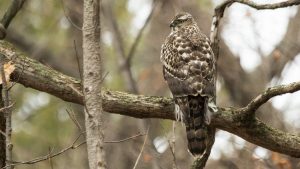Northern Goshawk
The raptor bird, being a large predator, is known for its size. The male goshawk is smaller than the female.
Scientific Classification
| Kingdom | Animalia |
| Phylum | Chordata |
| Class | Aves |
| Order | Accipitriformes |
| Family | Accipitridae |
| Genus | Accipiter |
| Scientific Name | Accipiter gentilis |
Quick Information
| Description | Size: 20.9-25.3 in (53-64.2 cm) Wingspan: 40.5-46.1 in (102.8-117 cm) Color: The upperpart of the body is dark gray while the underpart is pale gray, the head is dark, white-striped eyes Weight: 22.4-48.2 oz (635-1366 g) |
| Distribution | Iceland, Ireland, France, Spain, Great Britain, Kamchatka Peninsula, Russia, Sardinia, Corsica, Morocco, Himalayans, Tibet, Turkey, Western Canada, New Mexico, Pakistan, Iran, Jordan, Egypt, Libya, Israel, and Japan |
| Habitat | Coniferous and deciduous forest |
| Subspecies | 1. Accipiter gentilis albidus 2. Accipiter gentilis apache 3. Accipiter gentilis arrigonii 4. Accipiter gentilis atricapillus 5. Accipiter gentilis buteoides 6. Accipiter gentilis fujiyamae 7. Accipiter gentilis gentilis 8. Accipiter gentilis laingi 9. Accipiter gentilis marginatus 10. Accipiter gentilis schvedowi |
| Sounds and Call | ‘Kew-kew-kew’ in high pitch by males when delivering food, otherwise a repetitive ‘chuck’, sometimes females produce ‘kek-kek-kek’ when alarmed. |
| Lifespan | In the wild, they live up to 11 years and in the captivity, the lifespan is around 27 years |
| Diet | Jackrabbits, snowshoe hares, ground and tree squirrels, crows, ruffed grouses, sooty grouses, dusky grouses, gray jays, blue jays, Steller’s jays, and cottontails |
| Adaptation | 1. Their tail is wide and long whereas the wingspan is short, compared to the body length, all because both of these conditions help the bird to fly high. 2. The legs are heavily feathered to keep warm, during the cold weather. |
| IUCN Conservation Status | Least Concern |
Behavior
- These territorial birds either stay in pairs or alone
- They fly with low wingbeats and little glides
- The northern goshawks usually sit on high perches, watching over their preys and then suddenly attack them
Mating and Reproduction
The supposedly monogamous bird, displays amazing flights and indulges in proper vocalization during the mating and nesting season. Both the male and female make nests for the arrival of their babies with barks and sticks. The female northern goshawks lay 2-5 eggs. Initially, the eggs look bluish but that changes to off-white. Females incubate them for 35-42 days and sometimes males help in the process. Usually, male goshawks during this phase take care of the family, from gathering foods to protecting the female and unborns or newborns.


Life-cycle
After a successful hatching, juvenile goshawks stay with their mother for 5-6 weeks more. After that, they try flying by short flight and keep on trying until they become able to take long flights. Even after learning how to fly, young and sub-adult birds stay with their parents for a few weeks more. Within 10-12 weeks, they become completely independent of their parents and by this time, they turn into predators and birds of prey. However, some birds, stay with their parents for around 1 year. The sexual maturity of northern goshawks is achieved at 1-2 years.
Interesting Fact
- The genus name being “Accipiter”, meaning “hawk”, has come from the word “Accipere” meaning “to grasp” and the Latin name “gentilis” means “gentle” or “noble”. The bird used to be allowed for falconry to people with noble heredity only.
References
- https://www.allaboutbirds.org/guide/Northern_Goshawk/id
- https://wildernessclassroom.org/wilderness-library/northern-goshawk/
- https://www.audubon.org/field-guide/bird/northern-goshawk
- https://www.peregrinefund.org/explore-raptors-species/Northern_Goshawk
- https://nhpbs.org/wild/northerngoshawk.asp
- https://www.oiseaux-birds.com/card-northern-goshawk.html
Published on July 5th 2019 by Sahana Kanjilal under Coniferous Forest Animals.
Article was last reviewed on 17th July 2023.









